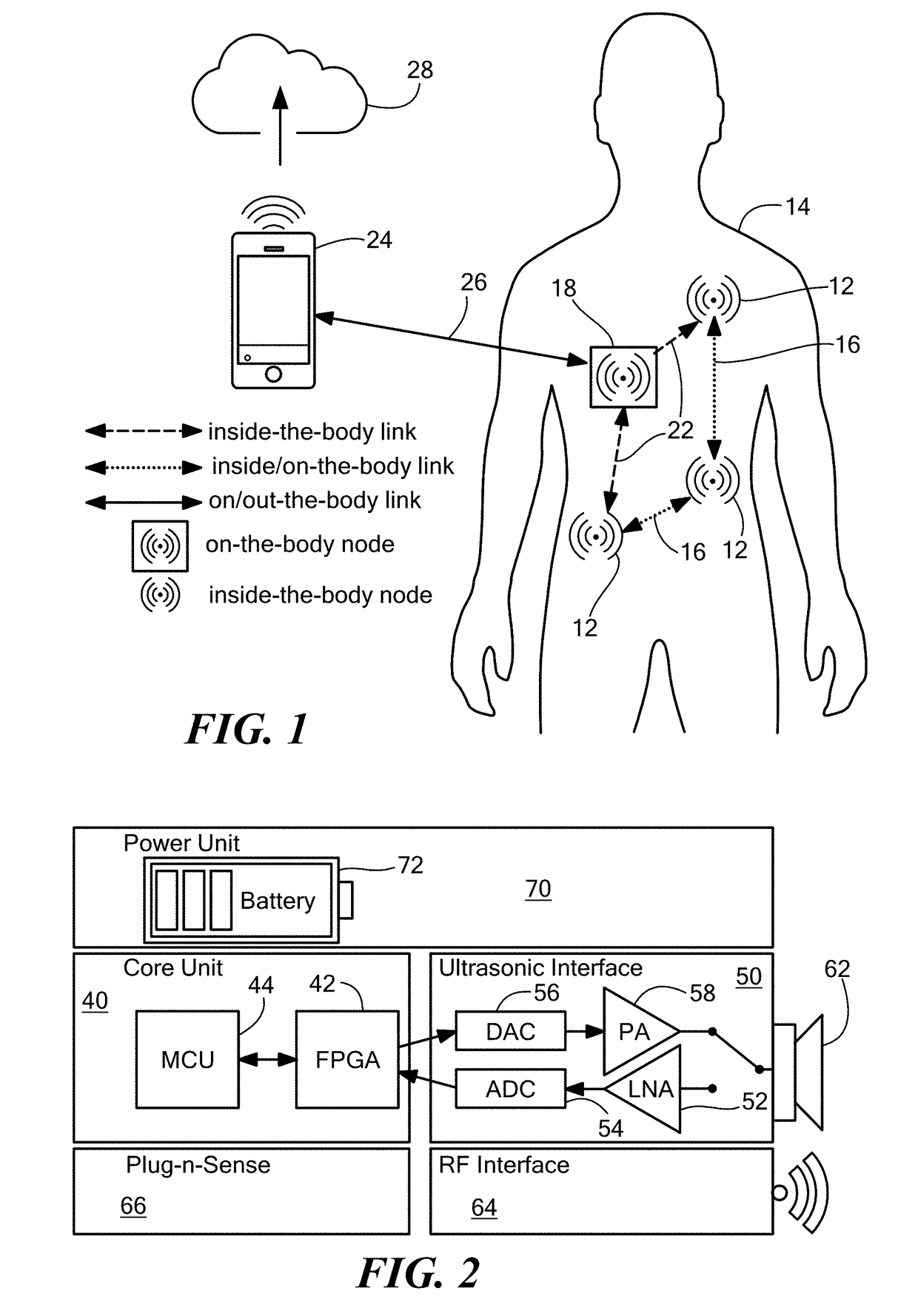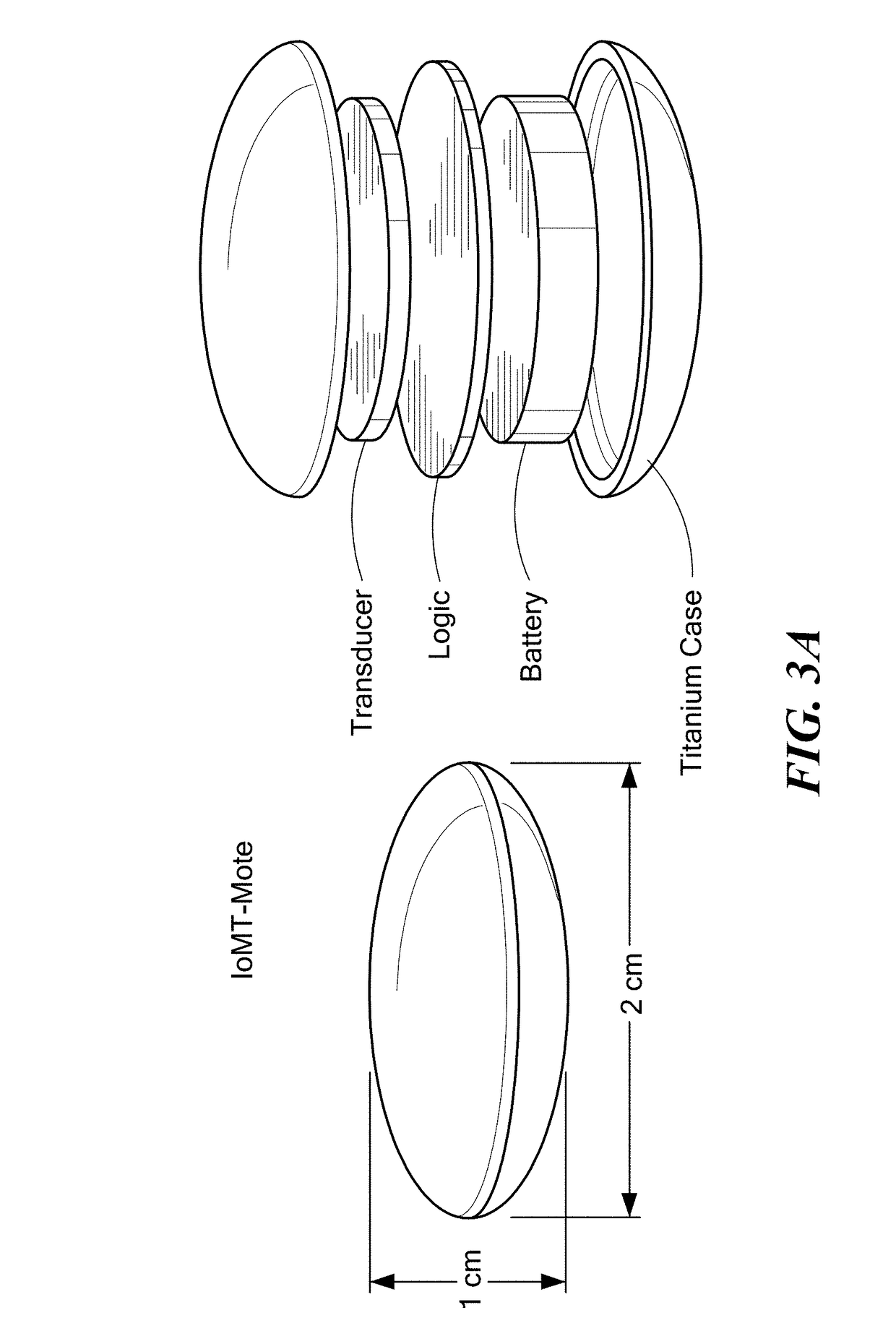Software-Defined Implantable Ultrasonic Device for Use in the Internet of Medical Things
a technology of implantable ultrasonic devices and medical things, which is applied in the field of software-defined implantable ultrasonic devices for use in the internet of medical things, can solve the problems of increasing the battery size reducing the battery life of the implantable device, and prohibiting continuous telemetry operation
- Summary
- Abstract
- Description
- Claims
- Application Information
AI Technical Summary
Benefits of technology
Problems solved by technology
Method used
Image
Examples
example 1
[0184]In this section, the energy consumption of the hardware of the IoMT-mote prototype is presented. Measurements were performed using a custom current sensing system based on the shunt resistor method. The shunt resistor method comprised sensing a current by measuring voltage drop along a small resistor, i.e., the shunt resistor, connected in series between the power supply and the load, i.e., the device under test (DUT). By dividing the voltage drop by the value of the shunt resistor, I=V / R, the current flowing through the resistor, and thus the current drawn by the DUT, was obtained. FIG. 11 shows a diagram of the measurement setup. In this setup, the voltage drop was measured using two analog inputs of the Saleae Logic Pro 8 logic analyzer to capture voltages at the two ends of a 1Ω shunt resistor. The voltage measures, sampled at 12.5 MHz, were saved on a host computer and exported to Matlab for processing; the voltage drop was obtained as the difference bet...
example 2
on Loss
[0195]FIG. 12 shows attenuation loss in pork meat for RF waves at 2.4 GHz and for ultrasonic waves at 700 kHz. The attenuation included absorption by tissue, conversion losses and spread losses. Measurements were performed by gradually increasing the amount of pork meat between the transmitting and receiving antenna, or transducer. For the RF measurements, the received power was measured by the CC2650 MCU, while for the ultrasonic measurements prototype, the received power was measured using the Saleae Logic Pro 8 logic analyzer. To avoid RF leakages that can affect the measurement results, the two CC2650 boards were enclosed inside two Faraday shielding bags to attenuate up to 82 dB the RF leakage and therefore reduce the undesired effect of in-air RF propagation. FIG. 13 shows an example of the RF measurement setup. It was observed that for 2 to 12 cm propagation distance, RF attenuation was 55 to 80 dB higher than the ultrasonic attenuation.
example 3
-Rate Evaluation
[0196]This example describes the performance the UsWB transmission scheme implementation on the IoMT-mote in terms of bit-error-rate as a function of the transmission power in different use-case scenarios. Ultrasonic phantoms were used that matched the acoustic properties of different human tissues, e.g., soft tissues, bones, and fluids. Specifically, an upper arm phantom and a thoracic phantom were used. The upper arm phantom emulated muscle tissue containing veins with fluid simulating blood. The thoracic phantom included the mid thoracic spinal segment containing spinal fluid, muscle, skin and other soft tissues. FIG. 14 shows the channel impulse response (CIR) of the two considered scenarios. The point at time=0 ms indicates the instant of transmission; the other points represent the time of arrival of the signal paths. It was observed that in the upper arm phantom almost no multipath effect was experienced, except for a secondary path caused by the reflection of...
PUM
 Login to View More
Login to View More Abstract
Description
Claims
Application Information
 Login to View More
Login to View More - R&D
- Intellectual Property
- Life Sciences
- Materials
- Tech Scout
- Unparalleled Data Quality
- Higher Quality Content
- 60% Fewer Hallucinations
Browse by: Latest US Patents, China's latest patents, Technical Efficacy Thesaurus, Application Domain, Technology Topic, Popular Technical Reports.
© 2025 PatSnap. All rights reserved.Legal|Privacy policy|Modern Slavery Act Transparency Statement|Sitemap|About US| Contact US: help@patsnap.com



